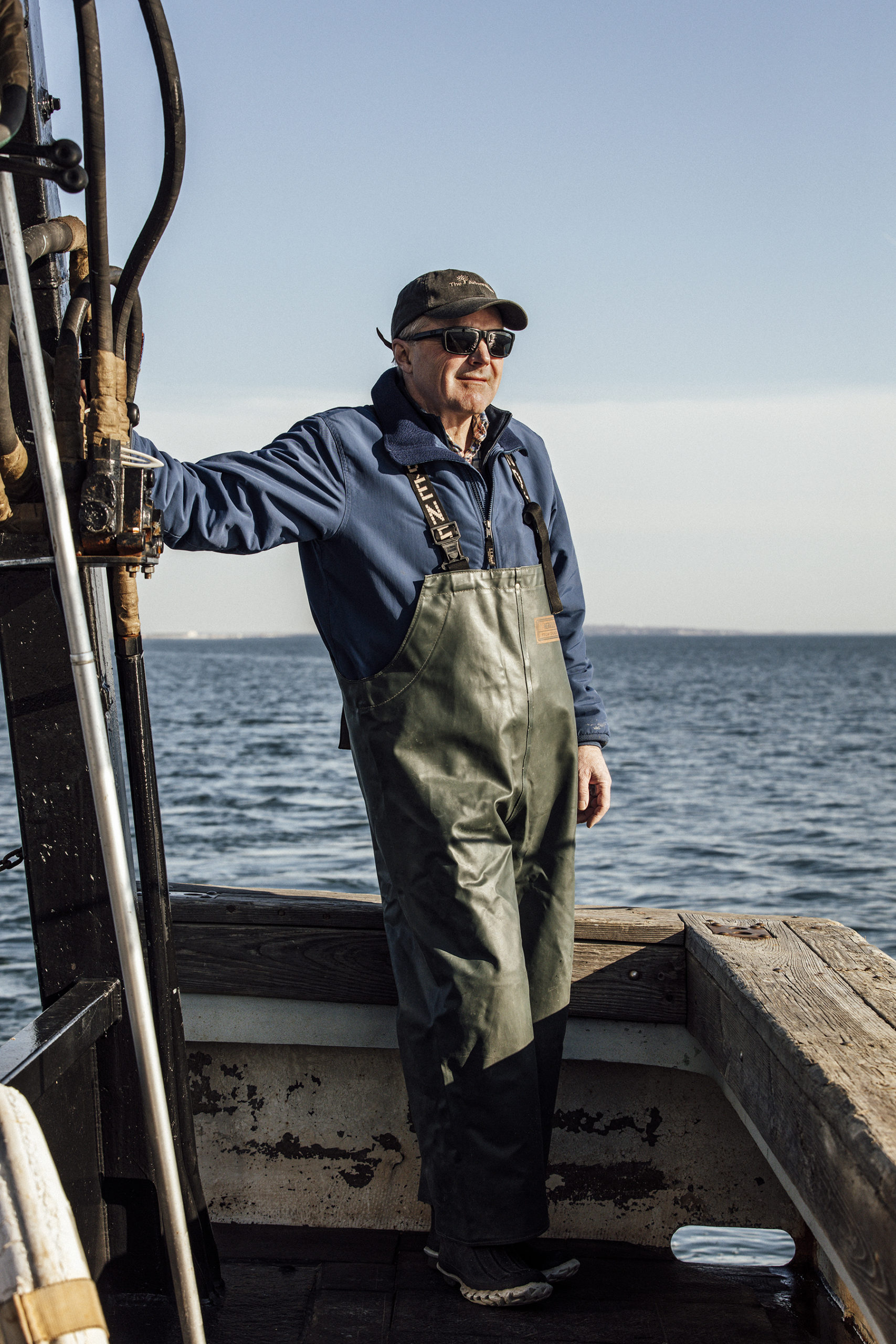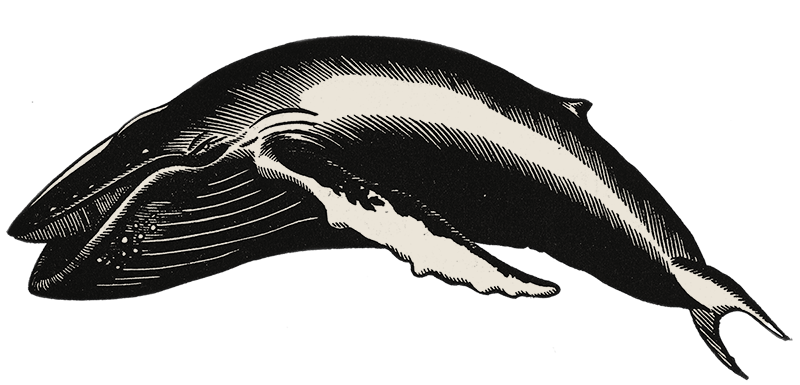Climate Migrants Altering Marine Communities
WARMING WATERS WELCOME NEW SPECIES FURTHER NORTH
By Todd McLeish | Photographs by Jesse BurkeAs Heather Kinney zigzagged across upper Narragansett Bay in her Nature Conservancy work-boat last fall, she stopped at 12 sites within 100 yards of shore to check the fish traps she had set four days before. The traps—small eel pots and others similar to lobster traps—were deployed to assess the abundance and diversity of fish that spend at least part of the year in the upper bay from Rocky Point in Warwick to Watchemocket Cove in East Providence.
“When the Narragansett Bay Commission reduced the nitrogen output of its wastewater plants by 50%, there was no record of how that affected the fish popu-lation,” says Kinney, The Nature Conservancy’s coastal restoration science technician. “There was anecdotal evidence that more fish were coming into the area, but no one was quantifying it. We want to see what the juvenile fish population is up here.”
While she has been somewhat surprised by the abundance of fish she found in her traps, it quickly became obvious that reduced nitrogen levels could not completely account for the fish she was catching. It was especially noticeable when she pulled up the eel traps, which caught large numbers of juvenile fish just a few inches long.
Most of the fish in the traps—sometimes 30 or 40 or more at a time—were young scup and black sea bass, two species that have grown in abundance in Rhode Island waters in recent years. Both prefer warmer water.
“WE STILL HAVE THE SAME CAST OF CHARACTERS … BUT THEIR ROLES HAVE CHANGED.”
The abundance of those two species, according to Kinney and other scientists, is a signal of the changing climate.
The temperature in Narragansett Bay has increased by nearly 3 degrees Fahrenheit since the 1960s, which has made the water more hospitable to an increasing number of fish species and marine invertebrates that were intolerant of the bay’s previously cooler water. While scup and black sea bass have been found in Narragansett Bay in small numbers for many decades, they are now among the dominant species in the region for much of the year.
“Fish and other marine species are very closely tied to their environment, to a specific range of temperatures and productivity,” says Anna Mercer, chief of the Cooperative Research Branch of the National Oceanic and Atmospheric Administration’s Northeast Fisheries Science Center in Narragansett. “As climate has changed, those conditions and where they’re occurring have altered—warmer waters are extending farther north, pushing cooler waters offshore or even farther north. So that intimate connection between fish and their environment has forced them to shift their location to stay in the environment they are adapted
to live in.”
Black sea bass is a prime example of species that scientists are calling “climate migrants,” those that have shifted their range northward due to the warming waters and other factors driven by the changing climate. Mercer says that black sea bass have traditionally been found in the waters of the mid-Atlantic states. The bulk of the commercial fishery for the species is in the Carolinas, Virginia, and Maryland. But now they are common in Rhode Island waters.
“The reason so many people are talking about black sea bass is because they’re prevalent and visible. Temperatures have become more hospitable for them here,” says Jeremy Collie, a professor of oceanography at the University of Rhode Island’s Graduate School of Oceanography who studies the changing fish populations in the region. “Recreational anglers, when they throw their hook in the water, they often come up with black sea bass whether they’re trying to catch them or not. They’re plentiful in trawl fisheries, too.”
“It seems that the climate impact is on the lobster, not on the crab.”

Collie manages a weekly fish trawl research project at two locations in Narragansett Bay that has been taking place for 60 years, the results of which illustrate how the fish community in the bay has changed as the water temperature has increased.
When the study began in 1959, the dominant species captured were cold-water fish like winter flounder, cunner, and hake. Now scup, butterfish, and other warm-water species are predominant.
“For the most part, we still have the same cast of characters in the bay, but their roles have changed,” Collie says. “Winter flounder was at the top of the bill back in the 60s and early 70s, and now it’s just a bit player. When you look at the phenology, the timing of when species come and go, the northern species are spending less time here, and the southern species are arriving earlier and departing later.”
The changing abundance and species composition of marine life in the bay is triggering other changes as well. Collie points to striped sea robin as a climate migrant that is having a significant impact on the marine environment. It was quite rare in the early days of the fish trawl project, and some years it wasn’t caught at all. But in recent years it has been recorded in Narragansett Bay more than 200 days per year. “They just fly over the bottom and vacuum up everything in their path, including juvenile lobsters and flounder,” Collie says. “Their thermal habitat has expanded, and now they’re having an ecological impact on the food web of the bay.”
The decline of lobsters in Rhode Island waters due to their intolerance for warming waters has triggered another kind of change. According to Collie, lobsters prefer water temperatures of about 61 degrees Fahrenheit, with 68 being their upper limit. But since Narragansett Bay usually warms above 68 in the summer, lobsters have declined precipitously in the bay and are now predominantly found in the Gulf of Maine and in deep, offshore waters where they find refuge from the warmth. Their decline has corresponded with an increase in Jonah crabs.
“Jonah crabs are a [northern] species, so there’s no reason they wouldn’t have been here all along, but maybe they’ve benefitted from fewer lobsters,” Collie says. “It seems that the climate impact is on the lobster, not on the crab.” Collie noted that the increasing abundance of cli-mate migrants in Rhode Island waters is most apparent in Narragansett Bay. It’s happening offshore as well, but in a slightly delayed manner. “The difference is that estuaries are more atmospherically forced; they respond more to weather because they’re shallow,” he explained. “In deeper water on the continental shelf, the forcing becomes less atmospheric and more driven by the strength of the currents. We see shifts in species abundance and productivity in estuaries first because they’re shallower and more responsive. But we see the same signals on the shelf, just a little bit later.”
“It made no sense to try to catch lobsters anymore.”
Many of these changes to the composition and abundance of fish species in local waters have had an impact on commercial and recreational fishing.
“Changes in the environment have forced the fishing industry to explore alternative fisheries and alter-native ways to support their businesses,” says Mercer. “North of Cape Cod, the declines in groundfish have been extremely hard on the fishing community, but the fishermen in Rhode Island are uniquely poised because they have access to not just northern species that have shifted north but also to southern species that are just coming into the area.”
Jonah crabs are a good example, she says.
As lobsters declined and Jonah crabs seemingly took their place, many fishermen who had targeted lobsters have made the transition to harvesting crabs using the same gear. The transition happened at the same time the market for crabs expanded. Offshore lobsterman Jim Violet always caught a few Jonah crabs in his traps as bycatch, but about 12 or 14 years ago he noticed that he was catching fewer and fewer lobsters and more and more crabs. Now he’s a full-time crabber.
“If we tried to catch both species at the same time, we probably wouldn’t do as well with either one,” he says. “Now that the lobsters have moved to deeper water and the crabs are so abundant, it made no sense to try to catch lobsters anymore.” Violet says that about half of the lobstermen he knows have switched to crabs, though some still target lobsters for part of the year. David Spencer, another long-time offshore lobster-man, still fishes for lobsters most of the year, but half of his yearly income now comes from Jonah crabs. And while the rapid changes taking place in the marine environment are challenging to adapt to, he doesn’t see it as a negative for the fishing industry. “When people talk about climate change, it always seems to be accompanied by doom and gloom for fisheries, but fishermen can adapt just as fish can adapt,” he says. “Having a supply of crabs to harvest has been a boon to southern New England fisheries, both inshore and offshore.”
It hasn’t been bad for recreational fishermen either. Rich Hittinger, vice president of the Rhode Island Saltwater Anglers Association, has been fishing since he was a kid in the early 1970s. Some of the species he caught back then, like winter flounder and striped bass, are harder to find these days, but he’s happy to catch some of the climate migrants that have moved into the area.
“From a recreational perspective, we have a surplus of some of the new fish in our waters, like black sea bass, which are delicious … you can get yourself some really good table food on a regular basis,” he says. “I’m even catching some cobia now. They used to be rare around here, but now we’re getting them more often.”
Scientists and fishermen alike note the challenges the rapidly changing fish populations have placed on efforts to effectively manage local fisheries. Many of the quotas in place for commercial species are based on data from the 1980s and 1990s, before many of the species shifted their ranges northward. The Rhode Island quota for black sea bass, for instance, is quite small, despite its abundance in local waters, because the quota was set from data collected when the fish was still primarily found off the mid-Atlantic states.
“Fisheries management is not nimble,” says Mercer. “There are lots of different layers and processes involved, and it makes it difficult to manage fisheries adaptively, which is what we need in a changing climate.”
WHALES TOO
It’s not just fish and invertebrates that are climate migrants, however. Some whales are, too, though the link to the changing climate is indirect.

It’s not just fish and invertebrates that are climate migrants, however. Some whales are, too, though the link to the changing climate is indirect.
According to Robert Kenney, emeritus marine scientist at the URI Graduate School of Oceanography, North Atlantic right whales—one of the rarest marine mammals on Earth —feed almost exclusively on the dominant species of zooplankton in the northwest Atlantic, Calanus finmarchicus. But the changing climate is shifting where the large patches of Calanus are found, forcing the whales to travel great distances in search of their prey.
“Right whales go to the places they went to with their mother in their first year of life to find food,” he says. “That’s how they learn where the good places are to eat. But now there might not be food there, or the patch might not persist as long, so they wander around and end up in new places. The more they wander, the more at risk they are for running into a ship or getting entangled in fishing gear.”
“Eventually they do find a new food supply, but many of the whales aren’t getting enough to eat,” he added. “They’re finding enough food to survive but not enough to reproduce, so the population continues to decline.”
All of which results from the warming temperatures and shifting currents caused by the changing climate. Few other marine mammals are considered climate migrants—yet—but as environmental changes continue, it’s likely that some may become so, and many other creatures will as well.
Jim Violet hopes that whatever additional changes are coming won’t force him to fish for something other than lobster and crab. “I should never say never, though. I always thought the lobster industry was so well-managed that I’d never have to fish for anything but lobster. But I ate my words on that,” he says. “I hope Jonah crabs will be around for the foreseeable future.”
It may be wishful thinking.
Contact Us
Telephone: (401) 874-6805
Email: allard@uri.edu
Contributor Guidelines
Please review submission guidelines to be considered. d

